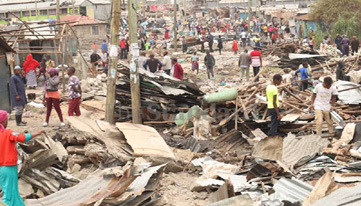(GIN)—An ambitious road construction project in Kenya’s capital, Nairobi, has demolished some 13,000 homes in the informal housing of Mukuru Kwa Njenga, technically a slum, ignoring human rights and leaving some 40,000 people homeless, says Diana Gichengo of Amnesty International Kenya.
Schools, businesses and homes across nearly 100 acres have been demolished since October as the government constructs the so-called “road for the rich” while others, forced by poverty, will be left to walk.
In the hastily run demolition, people lost clothing and other personal belongings. Dozens of families are now sleeping in makeshift tents in the rubble amid open sewage, during the seasonal rains. Left with no way of making money, some told the Guardian newspaper they have not eaten in days.
Approximately 2.5 million Kenyans live in about 200 of these settlements in Nairobi, representing 60 percent of the Nairobi population and occupying just six percent of the land. Kibera is the biggest slum in Africa and one of the biggest in the world.
According to Amnesty, Kenya’s National Highways Authority ignored well-established safeguards which would prevent forced evictions from taking place. And international financial institutions failed to carry out adequate due diligence to ensure the projects they fund do not cause or contribute to homelessness or other rights violations.
Roads and cars in Kenya have become synonymous with modernity. In a futuristic Nairobi, fewer people are on foot and there are more cars and roads, easing the city’s horrendous traffic congestion.
But more roads seem to fill up almost as fast as the country can build them, observes Kenyan journalist Patrick Gathara, and the city still has one of the world’s longest ride-to-work times.
Among the minority with cars—including most politicians and decision makers—walking or biking were almost never considered in the development plans. Lip service was paid to ideas like more pedestrian-only streets and car-free days.
Nairobi needs to get over its infatuation with the car, Gathara says, and focus on the needs of the majority who still walk, bike or take community buses. Rather than building expressways, the city should be building walkways and bike lanes and investing in mass transit, not just talking about it.
Resistance to the slum removal mounted for a couple of days until hundreds of armed police moved in with riot vehicles mounted with water cannons,” recalled Anami Daudi Toure of the Mukuru Community Justice Center.
“I ran to safety,” he adds. “I was lucky. When I came back to look for my belongings I saved my mattress, but everything else had been destroyed or picked up by street boys to sell.”
Financed by the China Road and Bridge Corporation, tolls expected to cost between $1 and $15 will be used to recoup their $550 million investment.
As Kenya’s election in August 2022 nears, the race to complete the road is seen as President Uhuru Kenyatta’s wish to complete his legacy project before his term ends.













